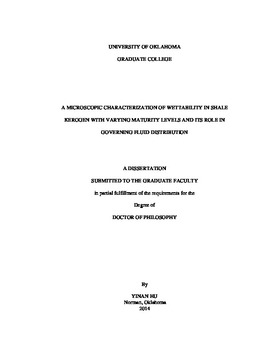| dc.contributor.advisor | Devegowda, Deepak | |
| dc.contributor.author | Hu, Yinan | |
| dc.date.accessioned | 2014-12-12T17:37:29Z | |
| dc.date.available | 2014-12-12T17:37:29Z | |
| dc.date.issued | 2014-12 | |
| dc.identifier.uri | https://hdl.handle.net/11244/13879 | |
| dc.description.abstract | Kerogen is defined as the insoluble macromolecular organic matter in sedimentary rocks and is a complex mixture of organic chemical compounds. The process of kerogen maturation is accompanied by the loss of functionalized molecules, leading to a decreased H/C and O/C ratios, as well as a reduction in molecular weight. The degree of thermal maturation is often expressed by the van Krevelen diagram with H/C and O/C ratios as indicators. Even though kerogen pores are widely viewed as hydrocarbon-wetting, some recent experimental work indicates the existence of water in kerogen. It then becomes necessary to evaluate the wettability characteristics of kerogen and to determine the governing factors controlling kerogen pore surface wettability.
Addressing these concerns is very essential because wettability is directly related to the dynamics of fluids and is likely to be extremely relevant to developing models for reserves estimates and multiphase flow. Additionally it may provide some answers to the common observation of low recovery of hydraulic fracture water.
In this study, pore-scale molecular dynamics simulations are used to understand the relationships between kerogen maturity and its wettability. The modeling approach adopted here includes a proper description of the kerogen pore systems with differing levels of thermal maturity, surface roughness, tortuous paths, and porous nature. Three kerogen models, namely activated kerogen, kerogen free of activated sites and the graphite slit pore are considered in this study. This work examines the sensitivity of the storage of pure water, brine water and a mixture of water and hydrocarbon to pore size, degree of kerogen maturity and pore wall roughness. A quantitative analysis to discuss the dependence of kerogen wettability on maturity degree is also presented.
The results indicate that the kerogen models constructed in this study more accurately represent organic pores in comparison to widely used planar graphite slit-pore systems. Confinement of water in kerogen pores is shown to lead to water entrapment and phase changes of water in comparison to its bulk properties. Fluid adsorption on the kerogen surface is observed to be multi-layer, instead of monolayer assumed in the Langmuir adsorption theory. Lastly, the results demonstrate that kerogen maturity governs wettability of organic kerogen pores. Kerogen of intermediate maturity is shown to be characterized by heterogeneous wettability and may lead to trapping of water in organic pores. | en_US |
| dc.language | en_US | en_US |
| dc.subject | Shale reservoirs | en_US |
| dc.subject | Kerogen wettability | en_US |
| dc.subject | Thermal maturation | en_US |
| dc.subject | Fluid behavior | en_US |
| dc.subject | Molecular dynamics simulation | en_US |
| dc.title | A MICROSCOPIC CHARACTERIZATION OF WETTABILITY IN SHALE KEROGEN WITH VARYING MATURITY LEVELS AND ITS ROLE IN GOVERNING FLUID DISTRIBUTION | en_US |
| dc.contributor.committeeMember | Civan, Faruk | |
| dc.contributor.committeeMember | Rai, Chandra | |
| dc.contributor.committeeMember | Jamili, Ahmad | |
| dc.contributor.committeeMember | Hawa, Takumi | |
| dc.date.manuscript | 2014-12 | |
| dc.thesis.degree | Ph.D. | en_US |
| ou.group | Mewbourne College of Earth and Energy::Mewbourne School of Petroleum and Geological Engineering | en_US |
| shareok.nativefileaccess | restricted | en_US |
